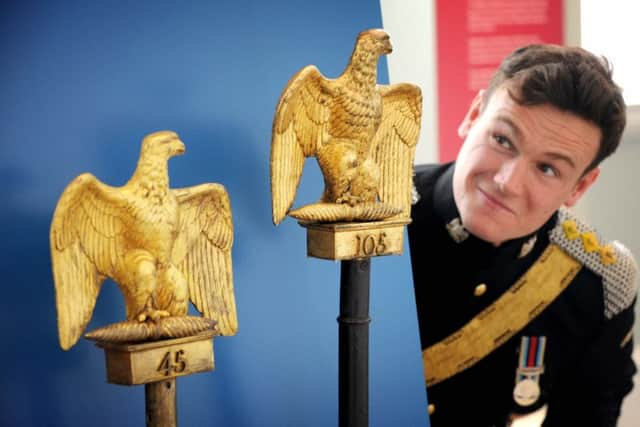Napoleon’s gold eagles reunited in Scotland


The gold standards were created to inspire pride and loyalty among the French forces – to lose them in battle was considered the ultimate shame.
Just two imperial eagles – fixed to the top of poles – were captured by the Duke of Wellington’s allied armies during the Battle of Waterloo, which ended more than two decades of bloody conflict.
Advertisement
Hide AdAdvertisement
Hide AdNow the eagles, which were famously sent back to London along with news of Wellington’s victory, have been reunited for the first time in almost 60 years for a new exhibition in Scotland.
The National Museum of Scotland has brought the two pieces back together for two weeks as part of a display to coincide with the run-up to the 200th anniversary of the battle next month.
They were on display together for decades at the Royal Hospital for retired soldiers in London before being split up in the 1950s when one of them was transferred to Scotland.
Commonly known as “Ewart’s Eagle”, it is usually in display at Edinburgh Castle to honour the heroics of Ayrshire-born Ensign Charles Ewart, who famously captured the regimental eagle of the 45th French Regiment.
It has gone on display at the museum alongside the eagle standard captured from the 105th French Regiment at Waterloo by Captain Alexander Clark of the Royal Dragoons, which effectively signalled victory for Wellington and the final defeat of the French military figurehead.
The eagles have gone on display in Edinburgh just weeks after precious regimental colours went on public display at Edinburgh Castle – exactly 200 years after five soldiers died trying to protect them at Waterloo.
The 6ft by 6ft colours of the 3rd Battalion of the Royal Scots – Britain’s oldest army regiment until its controversial demise in 2006 – are in such a fragile state that they have not been seen since they were taken off public display at St Giles Cathedral in the Royal Mile in 1934.
The two fragile flags have been taken out of storage for the first time in more than 80 years and given pride of place at Edinburgh Castle’s great hall, where they can be seen until the end of August. Then they will be archived forever to ensure they can be properly preserved.
Advertisement
Hide AdAdvertisement
Hide AdThe eagles were two out of nearly 100 which were presented by Napoleon to his armies in 1815. They are on display along with a series of exhibits depicting how people in Scotland reacted in the aftermath.
Other highlights include souvenir pottery made in Portobello, in Edinburgh, to celebrate the return of the Black Watch to Scotland after the battle; a travelling ink-pot said to have been used by Wellington at Waterloo; and the badge and whistle of a Special Constable in the burgh of Calton, Glasgow, from the period following the war which saw political unrest and violent demonstrations.
Dr Stuart Allan, principal curator at the museum, said: “All kinds of objects were brought back home in the aftermath of Waterloo, from mementoes and relics of individuals who lived or died, to such famous trophies as the two captured eagles.
“Tourists flocked to the battlefield, and returned with objects that they had found or bought locally in the flourishing market for souvenirs.
“At home in Scotland, there were public celebrations, and commemorative objects were popular, and there was a sense that the war had brought recognition for Scotland across Britain and Europe.
“But we can also see that acclaim over the victory was not universal. The immediate post-war years were times of political tension and conflict in Scotland, and there were many who continued in their admiration for the defeated Napoleon.”
Janice Murray, director general of the National Army Museum in London, which has loaned the eagle captured from the 105th French Regiment, added: “The 200th anniversary of Waterloo provides us with a perfect opportunity to explore, understand and value the stories and objects which survived this momentous battle.
“We’re delighted to be working with National Museums Scotland to show the eagle from the standard of the 105th infantry from our collection side by side with Ewart’s Eagle in Edinburgh.”